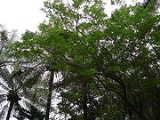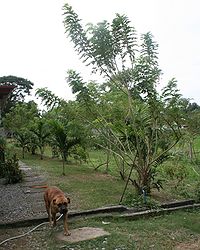
Gliricidia sepium
Encyclopedia
Gliricidia sepium, often simply referred to as Gliricidia (common names: Mata Ratón; Cacao de nance, Cachanance, it is commonly known as "Madreado" in Honduras
; Kakawate in the Philippines
; Madre Cacao or Madre de Cacao in the Philippines and Guatemala
; and Madero negro in Nicaragua
), is a medium size leguminous tree belonging to the family Fabaceae
. It is considered as the second most important multi-purpose legume tree, surpassed only by Leucaena leucocephala.
of 4.5-6.2. The tree is found on volcanic soils in its native range in Central America
and Mexico
. However, it can also grow on sand
y, clay
and limestone
soils.
 The tree is used in many tropical and sub-tropical countries for various purposes such as live fencing, fodder
The tree is used in many tropical and sub-tropical countries for various purposes such as live fencing, fodder
, coffee shade, firewood
, green manure
and rat poison. Live fences can be grown from 1.5 m to 2.0 m stakes of Gliricidia sepium in just a month.
G. sepium is also used for its medicinal and insect repellent properties. Farmers in Latin America
often wash their livestock with a paste made of crushed G. sepium leaves to ward off torsalos. In the Philippines
, the extract obtained from its leaves is used to remove external parasites.
G. sepium is a fast growing ruderal species
that takes advantage of slash and burn
practices in its native range. Its swift propagation has caused it to be considered as a weed in Jamaica
. Because it is easily propagated and grows quickly, it has also been suggested that this species may be planted to reduce topsoil
erosion
in the initial stages of reforesting
denuded areas, an intermediate step to be taken before introducing species that take longer to grow.
Live fences can be grown from 1.5 m to 2.0 m stakes of Gliricidia sepium in just a month. G. sepium is also used for its medicinal and insect repellent properties. In the Philippines, the extract obtained from its leaves is used to remove external parasites.
According to World Agroforestry Centre, this species is becoming an important part of farming practices in Africa. G. sepium has a combination of desirable properties. Because it fixes nitrogen in the soil, it boosts crop yields significantly without the expense of chemical fertilizers. In addition, it is tolerable of being cut back to crop height year after year. The trees go into a dormant state when they are cut back, so the root system is not competing straight away for the nutrients, and the crop is free to become established. The trees only really start to come out out of the dormant phase when the crop is already tall.
Honduras
Honduras is a republic in Central America. It was previously known as Spanish Honduras to differentiate it from British Honduras, which became the modern-day state of Belize...
; Kakawate in the Philippines
Philippines
The Philippines , officially known as the Republic of the Philippines , is a country in Southeast Asia in the western Pacific Ocean. To its north across the Luzon Strait lies Taiwan. West across the South China Sea sits Vietnam...
; Madre Cacao or Madre de Cacao in the Philippines and Guatemala
Guatemala
Guatemala is a country in Central America bordered by Mexico to the north and west, the Pacific Ocean to the southwest, Belize to the northeast, the Caribbean to the east, and Honduras and El Salvador to the southeast...
; and Madero negro in Nicaragua
Nicaragua
Nicaragua is the largest country in the Central American American isthmus, bordered by Honduras to the north and Costa Rica to the south. The country is situated between 11 and 14 degrees north of the Equator in the Northern Hemisphere, which places it entirely within the tropics. The Pacific Ocean...
), is a medium size leguminous tree belonging to the family Fabaceae
Fabaceae
The Fabaceae or Leguminosae, commonly known as the legume, pea, or bean family, is a large and economically important family of flowering plants. The group is the third largest land plant family, behind only the Orchidaceae and Asteraceae, with 730 genera and over 19,400 species...
. It is considered as the second most important multi-purpose legume tree, surpassed only by Leucaena leucocephala.
Description
Gliricidia sepium is a medium-sized tree and can grow to from 10 to 12 meters high. The bark is smooth and its color can range from a whitish gray to deep red-brown. It has composite leaves that can be 30 cm long. Each leaf is composed of leaflets that are about 2 to 7 cm long and 1 to 3 cm wide. The flowers are located on the end of branches that have no leaves. These flowers have a bright pink to lilac color that is tinged with white. A pale yellow spot is usually at the flower's base. The tree's fruit is a pod which is about 10 to 15 cm in length. It is green when unripe and becomes yellow-brown when it reaches maturity. The pod produces 4 to 10 round brown seeds . The tree grows well in acidic soils with a pHSoil pH
The soil pH is a measure of the acidity or basicity in soils. pH is defined as the negative logarithm of the activity of hydrogen ions in solution. It ranges from 0 to 14, with 7 being neutral. A pH below 7 is acidic and above 7 is basic. Soil pH is considered a master variable in soils as it...
of 4.5-6.2. The tree is found on volcanic soils in its native range in Central America
Central America
Central America is the central geographic region of the Americas. It is the southernmost, isthmian portion of the North American continent, which connects with South America on the southeast. When considered part of the unified continental model, it is considered a subcontinent...
and Mexico
Mexico
The United Mexican States , commonly known as Mexico , is a federal constitutional republic in North America. It is bordered on the north by the United States; on the south and west by the Pacific Ocean; on the southeast by Guatemala, Belize, and the Caribbean Sea; and on the east by the Gulf of...
. However, it can also grow on sand
Sand
Sand is a naturally occurring granular material composed of finely divided rock and mineral particles.The composition of sand is highly variable, depending on the local rock sources and conditions, but the most common constituent of sand in inland continental settings and non-tropical coastal...
y, clay
Clay
Clay is a general term including many combinations of one or more clay minerals with traces of metal oxides and organic matter. Geologic clay deposits are mostly composed of phyllosilicate minerals containing variable amounts of water trapped in the mineral structure.- Formation :Clay minerals...
and limestone
Limestone
Limestone is a sedimentary rock composed largely of the minerals calcite and aragonite, which are different crystal forms of calcium carbonate . Many limestones are composed from skeletal fragments of marine organisms such as coral or foraminifera....
soils.
Uses

Fodder
Fodder or animal feed is any agricultural foodstuff used specifically to feed domesticated livestock such as cattle, goats, sheep, horses, chickens and pigs. Most animal feed is from plants but some is of animal origin...
, coffee shade, firewood
Firewood
Firewood is any wood-like material that is gathered and used for fuel. Generally, firewood is not highly processed and is in some sort of recognizable log or branch form....
, green manure
Green manure
In agriculture, a green manure is a type of cover crop grown primarily to add nutrients and organic matter to the soil. Typically, a green manure crop is grown for a specific period of time , and then plowed under and incorporated into the soil while green or shortly after flowering...
and rat poison. Live fences can be grown from 1.5 m to 2.0 m stakes of Gliricidia sepium in just a month.
G. sepium is also used for its medicinal and insect repellent properties. Farmers in Latin America
Latin America
Latin America is a region of the Americas where Romance languages – particularly Spanish and Portuguese, and variably French – are primarily spoken. Latin America has an area of approximately 21,069,500 km² , almost 3.9% of the Earth's surface or 14.1% of its land surface area...
often wash their livestock with a paste made of crushed G. sepium leaves to ward off torsalos. In the Philippines
Philippines
The Philippines , officially known as the Republic of the Philippines , is a country in Southeast Asia in the western Pacific Ocean. To its north across the Luzon Strait lies Taiwan. West across the South China Sea sits Vietnam...
, the extract obtained from its leaves is used to remove external parasites.
G. sepium is a fast growing ruderal species
Ruderal species
A ruderal species is a plant species that is first to colonize disturbed lands. The disturbance may be natural , or due to human influence – constructional , or agricultural .Ruderal species typically dominate the disturbed area...
that takes advantage of slash and burn
Slash and burn
Slash-and-burn is an agricultural technique which involves cutting and burning of forests or woodlands to create fields. It is subsistence agriculture that typically uses little technology or other tools. It is typically part of shifting cultivation agriculture, and of transhumance livestock...
practices in its native range. Its swift propagation has caused it to be considered as a weed in Jamaica
Jamaica
Jamaica is an island nation of the Greater Antilles, in length, up to in width and 10,990 square kilometres in area. It is situated in the Caribbean Sea, about south of Cuba, and west of Hispaniola, the island harbouring the nation-states Haiti and the Dominican Republic...
. Because it is easily propagated and grows quickly, it has also been suggested that this species may be planted to reduce topsoil
Topsoil
Topsoil is the upper, outermost layer of soil, usually the top to . It has the highest concentration of organic matter and microorganisms and is where most of the Earth's biological soil activity occurs.-Importance:...
erosion
Erosion
Erosion is when materials are removed from the surface and changed into something else. It only works by hydraulic actions and transport of solids in the natural environment, and leads to the deposition of these materials elsewhere...
in the initial stages of reforesting
Reforestation
Reforestation is the natural or intentional restocking of existing forests and woodlands that have been depleted, usually through deforestation....
denuded areas, an intermediate step to be taken before introducing species that take longer to grow.
Live fences can be grown from 1.5 m to 2.0 m stakes of Gliricidia sepium in just a month. G. sepium is also used for its medicinal and insect repellent properties. In the Philippines, the extract obtained from its leaves is used to remove external parasites.
According to World Agroforestry Centre, this species is becoming an important part of farming practices in Africa. G. sepium has a combination of desirable properties. Because it fixes nitrogen in the soil, it boosts crop yields significantly without the expense of chemical fertilizers. In addition, it is tolerable of being cut back to crop height year after year. The trees go into a dormant state when they are cut back, so the root system is not competing straight away for the nutrients, and the crop is free to become established. The trees only really start to come out out of the dormant phase when the crop is already tall.
External links
- 2.2 "Gliricidia sepium - a Multipurpose Forage Tree Legume" in Forage Tree Legumes in Tropical Agriculture, Edited by Ross C. Gutteridge and H. Max Shelton. Tropical Grassland Society of Australia Inc.
- Gliricidia sepium (Jacq.) Steud. Purdue University.

